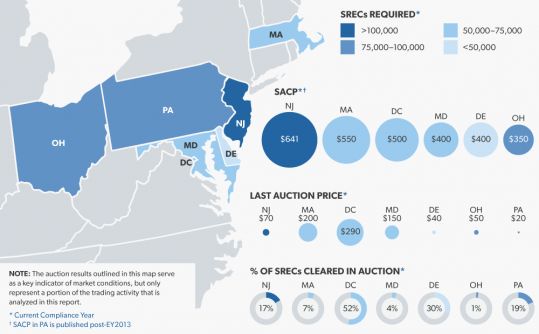SRECTrade and GTM Research today release SREC Market Monitor, the solar industry’s first quarterly report series devoted to covering state SREC markets in the U.S. With SREC programs forecasted to account for nearly 25 percent of the 3.2 gigawatts to be installed nationally in 2012, understanding the risk and opportunity latent in SREC states will be imperative for industry players.
At 72 pages, SREC Market Monitor: 2nd Quarter 2012 provides qualitative state-by-state SREC market analyses, regulatory policy updates affecting these markets, quarterly bid/offer pricing by state, data on SREC supply by state, historical SREC pricing, as well as updated RPS figures for each SREC market. The reports analyze the following markets: Delaware, Maryland, Massachusetts, New Jersey, Ohio, Pennsylvania, and Washington, D.C.
FIGURE: SREC Info Map, Q2 2012

Source: SREC Market Monitor: 2nd Quarter 2012
“Over the past five years, SRECTrade has specialized in providing liquidity, transparency and an unparalleled amount of insight into the complex movements of SREC markets across the U.S.,” said Brad Bowery, CEO of SRECTrade. “Our partnership with GTM Research now allows us to go beyond structuring transactions and reach a larger audience who can employ the market monitor to better assess the risk and opportunity of these complex SREC mechanisms.”
“State markets driven by SREC incentives now make up nearly 25 percent of total U.S. installations annually,” said Shayle Kann, VP of Research at GTM Research. “Our quarterly report series with SRECTrade strengthens our U.S. PV foundation and provides our clients with the most timely analysis on the SREC potential, as well as the possible pitfalls, for their businesses.”
For more information on SREC Market Monitor and to purchase a copy, visit www.greentechmedia.com/research/srec-market-monitor.
SAMPLE SREC ANALYSIS BY STATE
-
Where Will DOE’s Loan Program Make the Next Climate Tech Investments?
48
-
What the Frack Is Happening With Natural Gas Prices?
15
-
With an Energy Crisis Brewing, No Peak in Sight for Emissions
9
- NEW JERSEY: Trading volume increased in New Jersey as prices stabilized in anticipation of new legislation signed in July. Forward contracts have seen the largest increase in activity as the spot and forward price curves converge.
- MASSACHUSETTS: After two years of significant undersupply and high SREC prices, rates of installation increased dramatically in Massachusetts, leading to a 50% drop in the 2012 SREC spot price. As market participants adjust to the reality of oversupply, it is clear that the market will trade well below the price support in the early part of the year.
- MARYLAND: Maryland continues to find support in the legislature for its SREC program. In May, the solar carve-out requirements were moved forward by two years. While this change has kept Maryland from facing a pending oversupply, the market continues to grow at a rate designed to meet requirements under the new legislation.
- DELAWARE: In April, Delaware launched the pilot of its SREC Procurement Program managed by the Sustainable Energy Utility (SEU) and administered by SRECTrade on behalf of Delmarva Power. The program represents a significant shift in the state’s SREC market that could become a model for other states struggling with SREC volatility. It is the first independent, statewide solicitation for long-term SREC contracts.
- WASHINGTON, D.C.: The Washington, D.C. market continues to be a bright spot for the solar industry. Given the small, urban footprint of the district, the solar carve-out is an ambitious piece of legislation. Constrained by space, smaller solar installations will dominate this market, naturally preventing the wild swings in supply that have led to volatility in other markets.
- PENNSYLVANIA: SRECs continue to trade in the $20 to $30 range with an occasional spike. Despite attempts by sponsoring lawmakers, Pennsylvania continues to struggle to garner support for a legislative fix that would accelerate the solar RPS and create demand for SRECs.
-
OHIO: The market was particularly slow in Q2 as 2012 trading activity concluded. In-state demand had been strong over the past few years, but there has been a slowdown as supply has steadily grown to meet that demand. Meanwhile, the OH-adjacent market, which includes SRECs from states that border Ohio, continues to be significantly oversupplied.
Interested in purchasing this quarter's SREC Market Monitor? Click here to learn more.
